Abstract
OBJECTIVE: To determine if any preoperative or intraoperative factors can reliably predict malignancy in patients with Hürthle cell neoplasms. SUMMARY BACKGROUND DATA: Most experienced surgeons recommend total thyroidectomy for Hürthle cell carcinomas and reserve thyroid lobectomy for Hürthle cell adenomas. However, delineation between Hürthle cell adenoma versus carcinoma often cannot reliably be made either before or during surgery. METHODS: Medical records from 57 consecutive patients who underwent thyroid resections for Hürthle cell neoplasms between October 1984 and April 1995 at The Johns Hopkins Hospital were analyzed to determine if any factors were predictive of malignancy. RESULTS: Of the 57 patients with Hürthle cell neoplasms, 37 had adenomas and 20 had carcinomas, resulting in a 35% prevalence of malignancy. Patients with adenomas did not differ from those with carcinoma with respect to age, sex, or history of head and neck irradiation. However, patients with Hürthle cell carcinomas had significantly larger tumors (4.0 +/- 0.4 cm vs. 2.4 +/- 0.2 cm, p < 0.005). Furthermore, although the incidence of malignancy was only 17% for tumors 1 cm or less and 23% for tumors 1 to 4 cm, tumors 4 cm or greater were malignant 65% of the time (p < 0.05). Both fine-needle aspiration and intraoperative frozen section analysis had low sensitivities in the detection of cancer (16% and 23%, respectively). With up to 9 years of follow-up, there has been no tumor-related mortality. CONCLUSIONS: These data demonstrate that the size of a Hürthle cell neoplasm is predictive of malignancy. Therefore, at the time of initial exploration for large Hürthle cell neoplasms (>4 cm), definitive resection involving both thyroid lobes should be considered because of the higher probability of malignancy.
Full text
PDF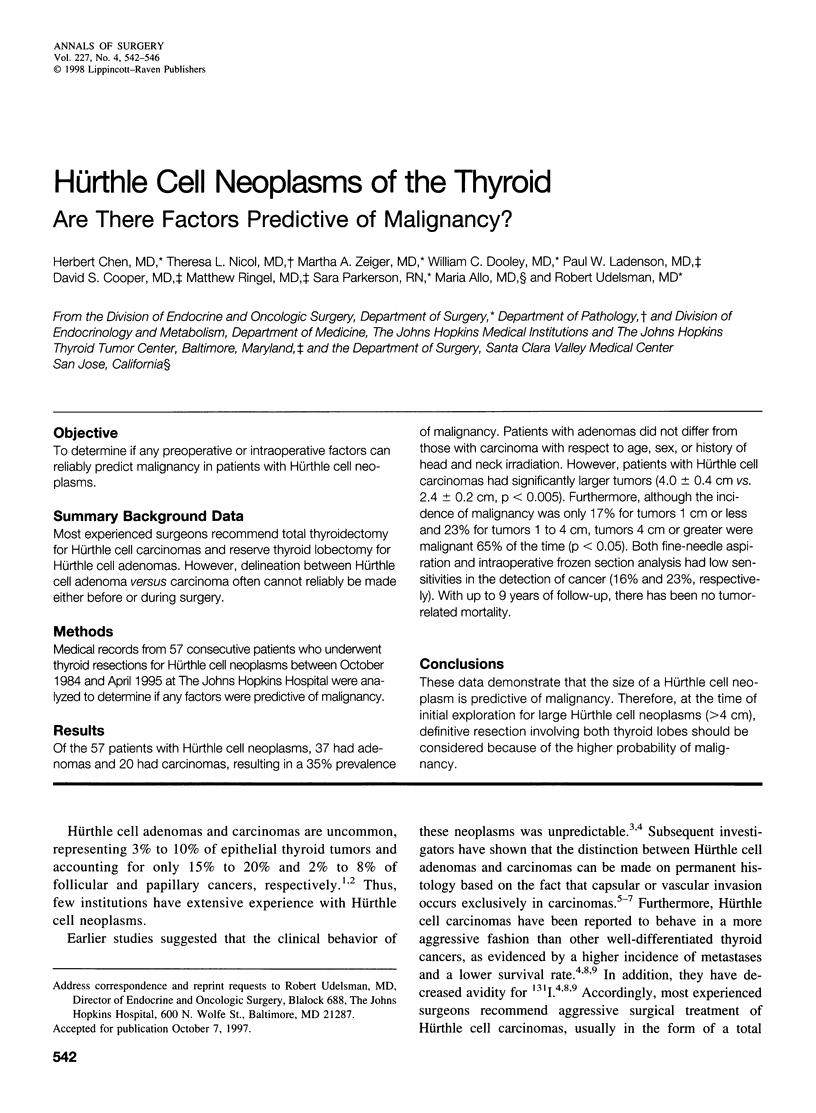
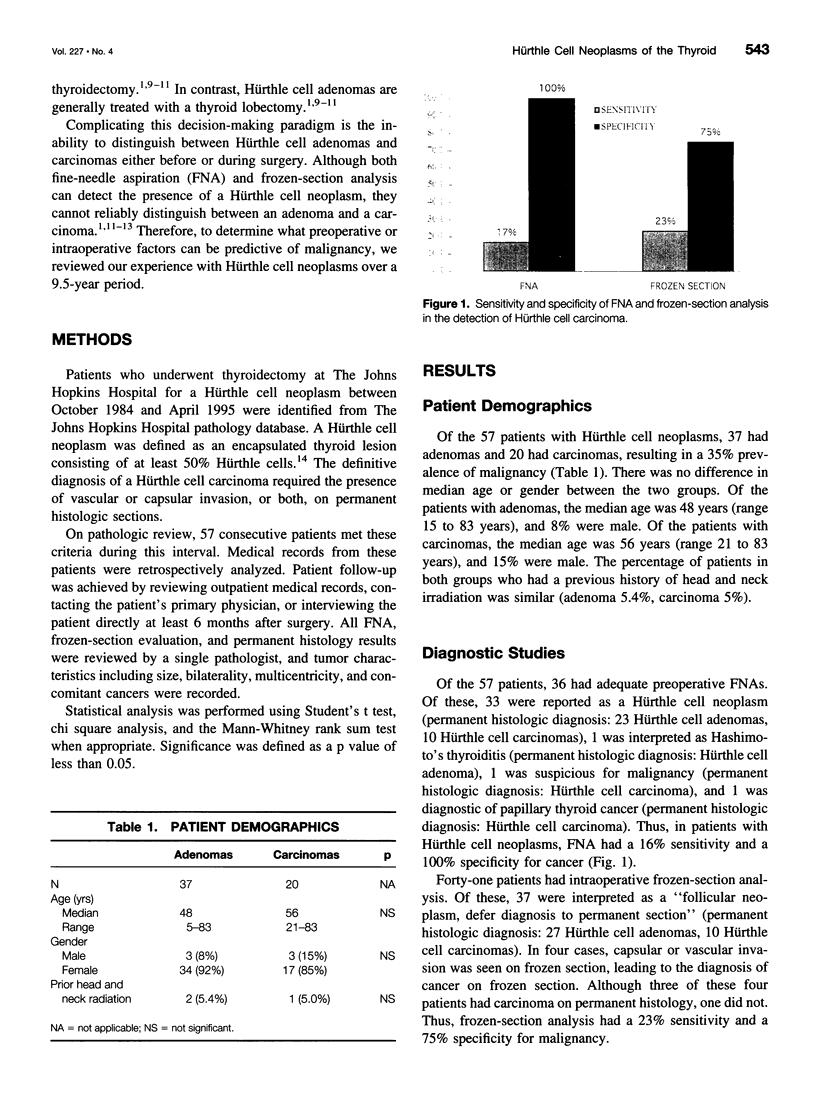
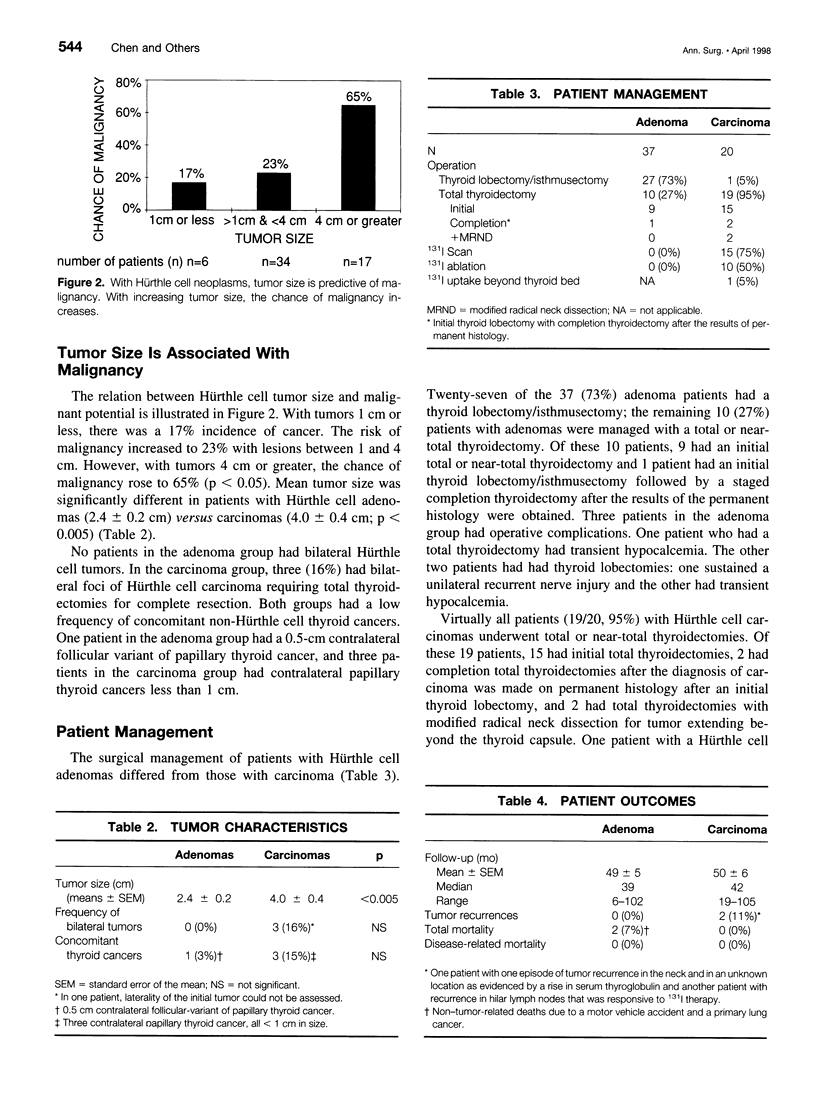
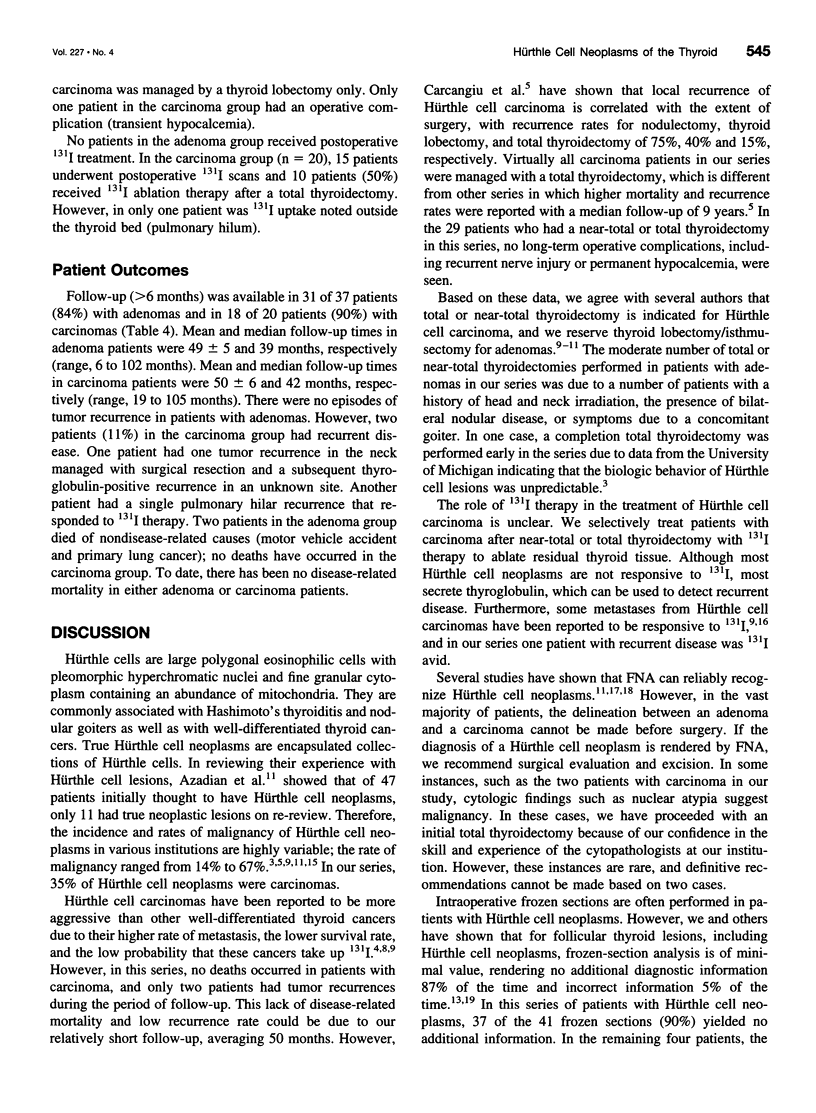
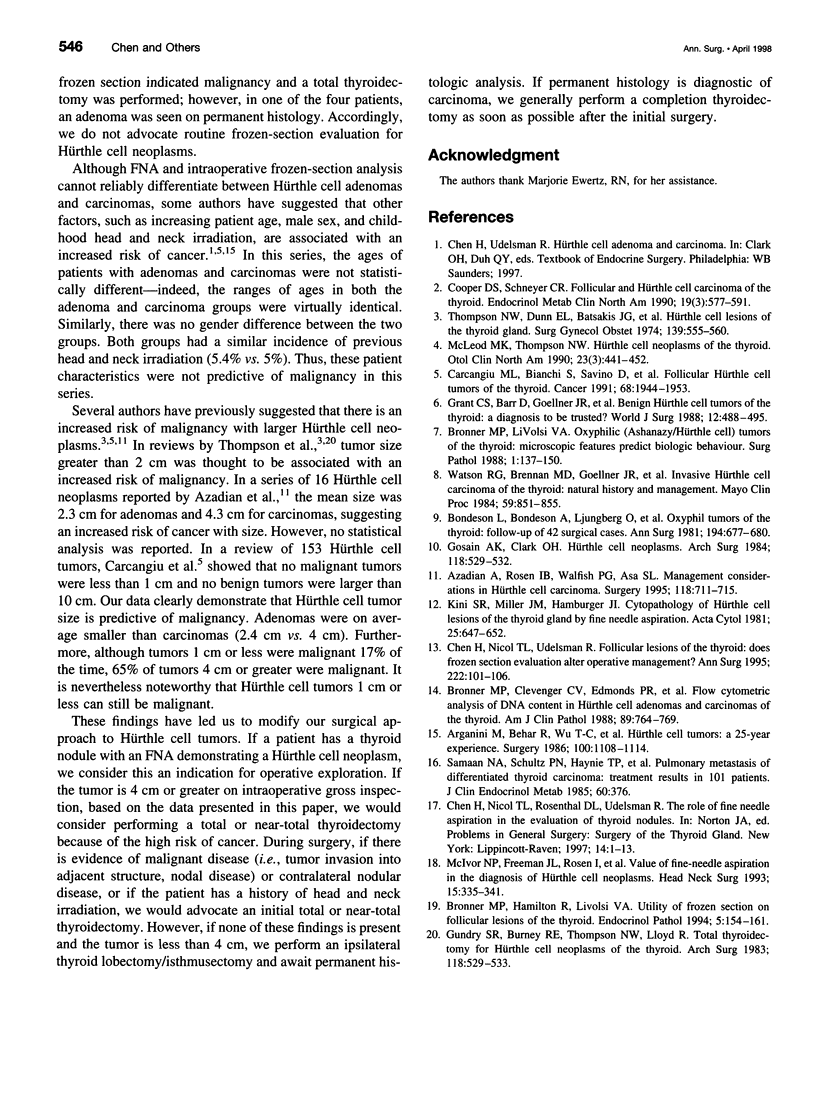
Selected References
These references are in PubMed. This may not be the complete list of references from this article.
- Arganini M., Behar R., Wu T. C., Straus F., 2nd, McCormick M., DeGroot L. J., Kaplan E. L. Hürthle cell tumors: a twenty-five-year experience. Surgery. 1986 Dec;100(6):1108–1115. [PubMed] [Google Scholar]
- Azadian A., Rosen I. B., Walfish P. G., Asa S. L. Management considerations in Hürthle cell carcinoma. Surgery. 1995 Oct;118(4):711–715. doi: 10.1016/s0039-6060(05)80039-x. [DOI] [PubMed] [Google Scholar]
- Bondeson L., Bondeson A. G., Ljungberg O., Tibblin S. Oxyphil tumors of the thyroid: follow-up of 42 surgical cases. Ann Surg. 1981 Dec;194(6):677–680. doi: 10.1097/00000658-198112000-00002. [DOI] [PMC free article] [PubMed] [Google Scholar]
- Bronner M. P., Clevenger C. V., Edmonds P. R., Lowell D. M., McFarland M. M., LiVolsi V. A. Flow cytometric analysis of DNA content in Hürthle cell adenomas and carcinomas of the thyroid. Am J Clin Pathol. 1988 Jun;89(6):764–769. doi: 10.1093/ajcp/89.6.764. [DOI] [PubMed] [Google Scholar]
- Carcangiu M. L., Bianchi S., Savino D., Voynick I. M., Rosai J. Follicular Hurthle cell tumors of the thyroid gland. Cancer. 1991 Nov 1;68(9):1944–1953. doi: 10.1002/1097-0142(19911101)68:9<1944::aid-cncr2820680917>3.0.co;2-i. [DOI] [PubMed] [Google Scholar]
- Chen H., Nicol T. L., Udelsman R. Follicular lesions of the thyroid. Does frozen section evaluation alter operative management? Ann Surg. 1995 Jul;222(1):101–106. doi: 10.1097/00000658-199507000-00016. [DOI] [PMC free article] [PubMed] [Google Scholar]
- Cooper D. S., Schneyer C. R. Follicular and Hürthle cell carcinoma of the thyroid. Endocrinol Metab Clin North Am. 1990 Sep;19(3):577–591. [PubMed] [Google Scholar]
- Grant C. S., Barr D., Goellner J. R., Hay I. D. Benign Hürthle cell tumors of the thyroid: a diagnosis to be trusted? World J Surg. 1988 Aug;12(4):488–495. doi: 10.1007/BF01655429. [DOI] [PubMed] [Google Scholar]
- Gundry S. R., Burney R. E., Thompson N. W., Lloyd R. Total thyroidectomy for Hürthle cell neoplasm of the thyroid. Arch Surg. 1983 May;118(5):529–532. doi: 10.1001/archsurg.1983.01390050013002. [DOI] [PubMed] [Google Scholar]
- Kini S. R., Miller J. M., Hamburger J. I. Cytopathology of Hürthle cell lesions of the thyroid gland by fine needle aspiration. Acta Cytol. 1981 Nov-Dec;25(6):647–652. [PubMed] [Google Scholar]
- McIvor N. P., Freeman J. L., Rosen I., Bedard Y. C. Value of fine-needle aspiration in the diagnosis of Hürthle cell neoplasms. Head Neck. 1993 Jul-Aug;15(4):335–341. doi: 10.1002/hed.2880150411. [DOI] [PubMed] [Google Scholar]
- McLeod M. K., Thompson N. W. Hürthle cell neoplasms of the thyroid. Otolaryngol Clin North Am. 1990 Jun;23(3):441–452. [PubMed] [Google Scholar]
- Samaan N. A., Schultz P. N., Haynie T. P., Ordonez N. G. Pulmonary metastasis of differentiated thyroid carcinoma: treatment results in 101 patients. J Clin Endocrinol Metab. 1985 Feb;60(2):376–380. doi: 10.1210/jcem-60-2-376. [DOI] [PubMed] [Google Scholar]
- Thompson N. W., Dunn E. L., Batsakis J. G., Nishiyama R. H. Hürthle cell lesions of the thyroid gland. Surg Gynecol Obstet. 1974 Oct;139(4):555–560. [PubMed] [Google Scholar]
- Watson R. G., Brennan M. D., Goellner J. R., van Heerden J. A., McConahey W. M., Taylor W. F. Invasive Hürthle cell carcinoma of the thyroid: natural history and management. Mayo Clin Proc. 1984 Dec;59(12):851–855. doi: 10.1016/s0025-6196(12)65621-3. [DOI] [PubMed] [Google Scholar]


